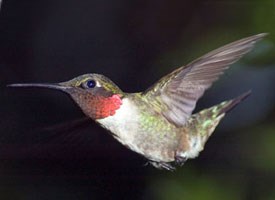A glimpse of green and red?
 |
| Ruby-throated Hummingbird www.allaboutbirds.org |
Your first sighted hummingbird?
 |
| Selasphorus Hummingbird, SP. Photo: Roger Levien/Audubon Photography Awards |
15 species of hummingbird are common in the US and Canada. The ruby-throated hummingbird is our local visitor to the Mid-Atlantic region. But aren't ruby-throated hummingbirds too small and too shy to observe in schoolyards here?
Hummingbirds will come to schoolyards as well as home gardens.
The key factor to attract ruby-throated hummingbirds is that they need their preferred food sources: tubular, mostly red-flowered nectar-producing plants.
Plant these native plants to attract and feed hummingbirds in our area throughout the season:
Red Columbine, Coral or Trumpet Honeysuckle, Scarlet Beebalm, Cardinal Flower.
 |
| Red Columbine Aquilegia canadensis Thriving in dry-shade, Arlington Traditional School |
 |
| Red Columbine Aquilegia canadensis April 2015 |
Red Columbine - Aquilegia canadensis
Adaptable to soil conditions and thrives in sun and part-shade
Flowers from April
Three-season appeal
Freely self-sows and is a great plant for spring school or club plant sales
 |
| Coral or Trumpet Honeysuckle Lonicera sempervirens Taylor Elementary School, Arlington |
 |
| Coral or Trumpet Honeysuckle Green Spring Gardens, Fairfax County |
Coral or Trumpet Honeysuckle - Lonicera sempervirens
Sun to part-shade
Needs to climb, so train on trellis
Reproduce by layered-cuttings
Coral honeysuckle flowers spring to fall
 |
| Scarlet Beebalm Monarda didyma Flowering in Shenadoah National Park, VA |
 |
| Scarlet Beebalm Monarda didyma Flowering in my yard Arlington, VA |
Scarlet Beebalm - Monarda didyma
Prefers fairly damp sites
Contain the planting borders as Beebalm spreads by roots as well as seeding
Flowers late in summer, July to September
Attracts hummingbirds, butterflies and native bees and honeybees
 |
| Red Cardinal Flower Arlington Science Focus School |
 |
| Red Cardinal Flower Green Spring Gardens, Fairfax County, VA |
 |
| Red Cardinal Flower - Lobelia cardinalis and Blue Cardinal Flower - Lobelia siphilitica For sale at Watermark Woods Nursery, VA |
If you have a courtyard or area protected from rabbits and deer, also try
Red Cardinal Flower - Lobelia cardinalis
You will notice all these plants have the red tubular flowers that the hummingbirds enjoy feeding from. I've also seen hummingbirds in my yard feeding from the eye-catching yellow early spring-flowering Carolina Jessamine, orange Turk's-cap Lilies (Lilium superbum) and coral-colored Agastache rupestris.
 |
| Turk's Cap Lily Lilium superbum in my garden, Arlington, VA |
 |
| Agastache rupestris Licorice Mint in flower, Arlington, VA and native to South-Western US |
For native plant resources local to Northern Virginia consult Plant NoVA Natives.
Toni Genberg, Arlington Regional Master Naturalist and partner author of the inspirational and informational blog ChooseNatives.org, lists resources for native plants in the Mid-Atlantic region. Toni, in addition to native plantings, recommends an easy-to-clean hummingbird feeder such as the Dr JB's feeder.

For school students:
Study hummingbirds and recording observations, and arrival and departure of visiting migrant hummingbirds as part of a citizen science program such as Journey North's Hummingbirds or Audubon Society's Celebrate Hummingbirds.
The datasets compiled over years contribute to our understanding of climate change.
Reflect on the moment of delight and wonder.
Here's my poem about a hummingbird I saw and heard last year.
Chance
I hear a soft call
And turn to see the hummingbird:
Hover, glance and fly away
Resources:
 |
| Image: Dorothy Edgington Journey North - Hummingbirds |
 |
| Image: Laura Erickson |
Journey North - Hummingbirds
https://www.learner.org/jnorth/humm/index.html
Program with maps and apps, and learning resources to observe and record the migration of hummingbirds in your area of the United States.
Your school can contribute data and record their arrival and departure in your area.
Project Budburst
http://budburst.org/
A national citizen science program focussed on the timing of plant cycles (phenology).
Observe and record the time of the budding, flowering and seeding of flowers such as Aquilegia canadensis in your schoolyard.
This year the Aquilegia is out in my yard one week prior to my hummingbird first sighting.
Audubon Society - Celebrate Hummingbirds
National program.
Download the Hummingbird app to record your sightings and contribute to citizen science.
Cornell Lab of Ornithology - Life Cycle, History, Bird Songs
http://www.allaboutbirds.org/guide/Ruby-throated_Hummingbird/id
Native Plants for Northern Virginia - www.plantnovanatives.org for further information on native plants in Northern Virginia, demonstration native plant gardens and local resources.
ChooseNatives.org - for further information on selecting native plants for the Mid-Atlantic region
Credits:
Thanks to Toni Genberg (ChooseNatives.org) for inspiration and insight.

Thanks for the beautiful photos and suggestions. What time do you expect to see the hummingbirds? It seems that some flowers are late to bloom this year in Arlington.
ReplyDeleteI see that a ruby throated hummingbird was sighted at a feeder in Silver Spring today!
Delete...and Toni saw a ruby-throated hummingbird yesterday at a feeder in Falls Church. Her email about that prompted me to write this blog piece! Also sightings from Fairfax County posted on a friend's FB last weekend. There are a few flowers already blooming in early spring that these hummingbirds feed on including Aquilegia, Red Columbine and Carolina Jessamine. So I am keeping a look out!
Delete